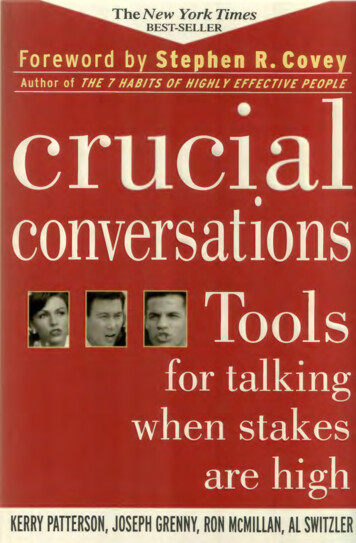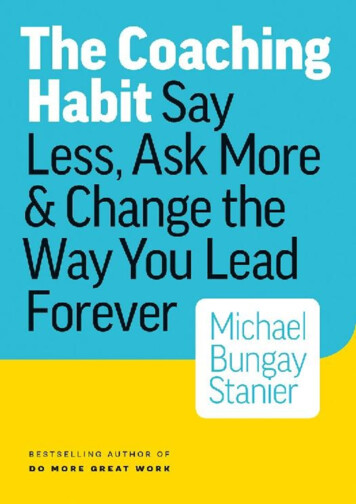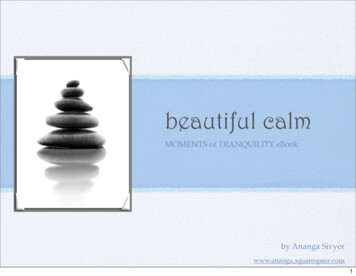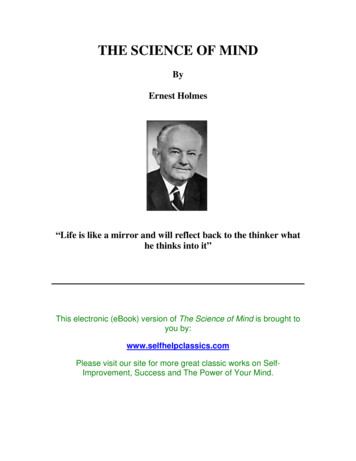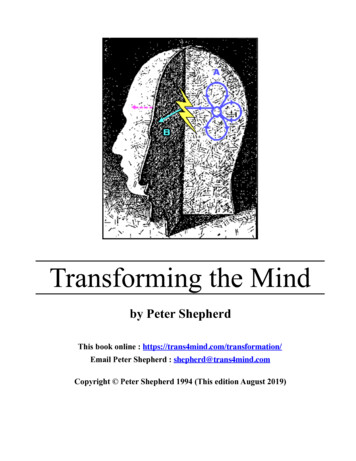
Transcription
“Best Of”Powerfull Living ArticlesThe Top Articles From 2000-2006For Personal and Business SuccessBy Lorraine CohenExecutive & Business CoachLife Strategist Expert
The Best of “Powerfull Living Articles” by Lorraine Cohen - 2000-2006Table of ContentsCREATING YOUR ROADMAP TO SUCCESS . 3FEAR OF SUCCESS? FEAR OF FAILURE? WHAT’S HOLDING YOU BACK?. 7UNCERTAINTY - THE DOORWAY TO POSSIBILITIES . 10GIVE AN “A". 12SMALL BUSINESS SPOILER – PROCRASTINATION . 14MAKE YOUR PITCH – TURNING CHIT CHAT INTO BIG BUSINESS . 17“SECRETS” TO FEELING POWER-FULL IN AN UNCERTAIN WORLD. 22NAVIGATING THROUGH TRANSITION AND COMING OUT ON TOP . 26NEGATIVITY – HOW IT IMPACTS YOUR BUSINESS AND PERSONAL SUCCESS . 31I WANT TO BE HAPPY . 34STOP TALKING AND START LISTENING! . 36RECHARGING YOUR BATTERIES . 39BONUS ARTICLE! WHOO-HOO!!!!! . 43ABOUT THE AUTHOR. 45MY FAVORITE QUOTE . 47Page 2Powerfull Livingwww.powerfull-living.bizCopyright 2006 by Lorraine CohenAll Rights Reserved. Duplication or distribution is prohibited
The Best of “Powerfull Living Articles” by Lorraine Cohen - 2000-2006Creating Your Roadmap To SuccessDo you have some goals and dreams you want to achieve? Do you believe you are hereon this earth for a purpose? Do you have a life passion you feel compelled to fulfill?Creating a vision is an important key in reaching the outcomes you desire.What is a Vision?A vision represents what you see as possible for yourself, others, and THE WORLD.Your vision provides the “The View” of your life; a state or outcome you can see thatnaturally draws, attracts, and pulls you forward with excitement, joy, or creativeinspiration.Powerfull VisioningWritten as a story, single sentences, drawn as a picture, a collage.visions can takewhatever shape is most meaningful to you. The point?1.2.3.4.5.6.7.How do you know what you want if you don't define it?How will you know when you get there if you don't know where ‘there’ is?Putting things down on paper makes what you think or say – REAL.Saying and seeing what you truly want in your life opens you up to HAVING it!Allowing you to step back and view your life from a fresh perspective.Creating hope and possibility.Compelling you to TAKE ACTION and ‘claim’ what you want!Questions that evoke clarity in creating a vision: What do you truly want to experience or accomplish for yourself, personally andprofessionally?Where do you want to see your life a year from now?What do you want to change/add/eliminate in your life?If money were not an issue, what would you be doing?What brings you joy? Makes your heart sing?What does your perfect life look like?Your vision is your plan for your life. To live your life you must live your vision. Dareto dream big and take the chance that your dreams might come true. Open your eyesand your mind by opening your heart and soul to possibilities. For whose life is itanyway? It is yours."Imagination is everything" - Albert EinsteinImagine yourself on the 31st day of December looking back over this past year. Whatchanges do you want to see? What challenges have you overcome? What are you mostproud of having accomplished? Who have you become?Page 3Powerfull Livingwww.powerfull-living.bizCopyright 2006 by Lorraine CohenAll Rights Reserved. Duplication or distribution is prohibited
The Best of “Powerfull Living Articles” by Lorraine Cohen - 2000-2006In Keith Ferrazzi’s book, “Never Eat Alone”, (a book I HIGHLY recommend!), he says,“A goal is a dream with a deadline.” I just love that definition.Now that you’ve created your vision, it’s time to identify your goals, right? The next stepis to write out a clear list of goals, commit to timelines and action steps. After all, unlessyou clearly define what you want, how will you create an action plan and strategy toreach them?So, what’s your success with goal setting? Are your results better than makingresolutions? About the same? If you make a list of goals and find you have difficultyreaching them, you’re not alone.Read some statistics from the American Society of Training & Development.The probability of achieving a goal if: You hear an idea, is 10% You decide when you will do it, is 40% You plan how you will do it, is 50% You commit to someone else you will do it, is 65% You have a specific accountability appointment with the person you've committedto, is 95%Many people start out with the best of intentions to reach their goals. Typically, afterabout two to three weeks, enthusiasm and motivation wanes from a variety of factorsincluding unrealistic expectations, challenges that arise, negative self-talk, and fears.You more than double your chances of success when you move from a decision intoa commitment, when you have someone in your corner to report back to on yourprogress. Imagine having someone to cheer you on and hold you accountable to be yourbest.In “The Power of Intention”, Wayne Dyer defines intention as “a strong purpose or aim,accompanied by a determination to produce a desired result.”Does intention mean you are willing to do whatever it takes to attain a result? Does itmean you must be fully committed to what is desired? Perhaps it is more accurate to saythat intention is the first step towards being engaged and fully committed to your visionand your goals. Of course the desire has to be strong enough for a total commitment!In my opinion, commitments are really agreements and promises we make to ourselves,and others. When we agree to do something, we make promises that reflect our integrity.When we break agreements and promises, we might feel disappointed, frustrated or angrywith ourselves. Breaking agreements might be the result of committing to something thatyou feel you should do rather than what you really want.Page 4Powerfull Livingwww.powerfull-living.bizCopyright 2006 by Lorraine CohenAll Rights Reserved. Duplication or distribution is prohibited
The Best of “Powerfull Living Articles” by Lorraine Cohen - 2000-2006Having a vision and an action plan is great. If you lack the passion or commitment tothat result and don’t take action, all you have are good ideas that are going nowhere! Askyourself, “Does my vision reflect what I really want or what I think I should want?” Ifnot, then your goals won’t excite you to take action. If your vision is not yours, then youare living someone else’s life.The bottom line: I believe that to achieve success you must begin with a strong intention.In other words, how badly do you want it? What are you willing to do to make ithappen? Adding your burning desire to intention to your commitment is a key ingredientto successfully reaching a goal. Identifying your goals allows you to clearly define whatyou really want. Having clarity will aid you in developing your strategy and roadmap forsuccess.Your call to action:Refer to your Vision. If you don’t have a vision, create one.Focus on the goals and dreams you wish to achieve. I strongly recommend you writedown a detailed list of all of your goals and dreams. Writing down specific details willhelp you view what you wish to attract, create, or achieve from a different vantage point.You might want to begin your statements by saying “My goal is , my dream is , Iwant ” Paint a picture in your mind and describe it (or draw, paint, make a collage) onpaper.Describing in detail what you envision, will provide a tangible and concrete picture onwhich to place your focus and intention.Make your goals realistic and attainable. If they are too high and unrealistic, you aresetting yourself up for failure and disappointment. Goals and dreams that both stretchyour comfort zone and excite you to action will empower you to succeed.Read over what you wrote and review your answers.1. Is this what you really, really want? If it isn’t, what do you want, really?2. Do you feel a burning desire and passion for what you really want? I know this mayseem a bit dramatic. The point is that to move from intention into commitment, thedesire must be strong enough to overcome whatever obstacles might arise. So, thisquestion speaks to “how important is your dream or goal to you? What are youwilling to do to accomplish it? If your desire isn’t that strong, then return to question#1 for greater clarity.3. Assess your commitment level. Look at your list of goals and dreams. Rewrite yourlist to begin each statement with “I intend to ” For example: Your goal may be to4. Read each new statement out loud. Notice what are you thinking and feeling. Do youfeel engaged and committed to “go for it?” If not, return to steps 1-3.Page 5Powerfull Livingwww.powerfull-living.bizCopyright 2006 by Lorraine CohenAll Rights Reserved. Duplication or distribution is prohibited
The Best of “Powerfull Living Articles” by Lorraine Cohen - 2000-20065. You now have the beginnings of a plan of action and strategy based on goals anddreams anchored in intention. What do you need to get from here to there? Actionplan, strategy, systems, people, experts, time, etc.Step out of the box - change the way you think about goal setting. Think about fulfillingyour intentions by goals as meandering with purpose. I love this approach!Meandering with purpose adds flexibility into goal setting so that you are open toopportunities and experiences that might take you in directions that bring you greaterresults than you could have imagined for yourself. Notice the ways the Universe bringspeople and opportunities into your life to help you grow so that you can fulfill yourvision, purpose, and mission.Or, create a theme for the year such as: being in contribution to others, financialindependence, success, peace, or personal growth. Choose actions that support yourtheme.Add accountability to your action plan. (Psst – like hiring a COACH!)The next step is up to you! Ready, set, GO!Page 6Powerfull Livingwww.powerfull-living.bizCopyright 2006 by Lorraine CohenAll Rights Reserved. Duplication or distribution is prohibited
The Best of “Powerfull Living Articles” by Lorraine Cohen - 2000-2006Fear of Success? Fear of Failure? What’s Holding YOU Back?One of my clients came to me saying he wanted to expand his business - something hehad thought about for years. He described the changes he wanted to make. He said hehad taken little action to make those changes happen despite many attempts to moveforward. When he talked about what he wanted, his eyes lit up, he smiled, and there waspassion and joy in his voice. Years? What was stopping him? He said “My business isgoing well, and it’s not like I have to make changes, maybe it's not that important onand on."Over the years, he has continued to feel an internal struggle to move forward in ways thatchallenged his comfort zone. Bottom line – he continued to feel restless because somepart of him was unfulfilled.On the surface, it sounded like the changes he wanted to make were for financial gains.Talking further, he realized he was really speaking of a level of service (how he wantedto help people improve their quality of life) and personal fulfillment (actualizing hisvalues, purpose, and vision) that would come from aligning who he is and what he doesin a BIGGER way. He was describing a desire to ‘be in contribution’ to others by livinghis passion and purpose.We discussed the things he told himself that kept him stuck. His initial objection was “IfI put myself out there and take some risks- what if I fail?” (What if this or thathappens?) I replied, “With all the years of experience you have thinking about whatyou want without committing to action, you have brilliantly SUCCEEDED in FAILING!Congratulations!!!”His eyes widened, and he burst out laughing. By doing nothing, he successfully insuredhis failure!Going forward in our coaching sessions, we focused on his attitudes about success andfailure. We spent considerable time identifying his values, needs, purpose, and vision.Increased self-awareness enabled him to make choices and design strategic actions tocreate greater life satisfaction and self-fulfillment.Why do people fear success? Having to maintain a high level of success can be daunting.Many people believe (fear) that when you’re at the top, the only place to go next, isdown. Success is life changing both personally and professionally. Success brings lossesand gains such as friends, lifestyle, etc. Success can go to one’s head and have a negativeimpact. You know the old saying “It’s lonely at the top.” Examples of fear of successinclude: fear of commitment, responsibility, change, or fear of growing up, (beingmature/an adult). For many, fear of success is scarier to many people than failure.Page 7Powerfull Livingwww.powerfull-living.bizCopyright 2006 by Lorraine CohenAll Rights Reserved. Duplication or distribution is prohibited
The Best of “Powerfull Living Articles” by Lorraine Cohen - 2000-2006Five common beliefs regarding success: People expect a lot from me and I must consistently deliver at a high levelIf I succeed, people will expect me to succeed at everything I doSuccess has to be hardThis will take too longThis is too hardWhy do people fear failure? Many people associate self-value and self-worth by theirsuccess and accomplishments. How often do we measure success by how well or howfast goals are reached? Failure equates to loss of love, money, respect, job, family,situation, etc. Examples of fear of failure include: fear of rejection, not being goodenough, or confrontation.Five common beliefs regarding failure: I have to get it right (perfect)I don’t have what it takesIf I say no, people won’t like meI have nothing valuable to offerIf I’m really “me” people won’t want /like/love meIf you feel fear is holding you back from moving forward, below is an exercise to helpyou gain greater clarity.Your call to action:Consider a change you have been thinking and talking about for a while without muchprogress. To learn more about what may be holding you back from moving forward,write down your answers to the following questions:1. What is my definition of success? What does success mean to me? Be specific.2. Identify specific successes. What made these successes for me? What value did Ireceive from succeeding?3. What fears, concerns, or assumptions do I have associated with success?4. How would my life change if I were/felt more successful?5. What would I have to give up?6. What would I gain?7. Who would I become? Would I be happier, more self-confident, authentic, orstronger? How would I feel? What would I be thinking?Page 8Powerfull Livingwww.powerfull-living.bizCopyright 2006 by Lorraine CohenAll Rights Reserved. Duplication or distribution is prohibited
The Best of “Powerfull Living Articles” by Lorraine Cohen - 2000-2006Explore your attitudes about failure. Write your responses to the following questions:1. What is my definition of failure? What does failure mean to me?2. If I fail at something, does that define ME as a failure?3. What specific failures have I experienced? What value have I received from failing?Be specific.4. What fears, concerns, or assumptions do I associate with failure? Are they true?5. Can there be success in failure? If yes, how? If no, say more.6. If I could not fail, what would I be doing?7. Who would I be?Schedule time to answer these thought-provoking questions – it’s a lot to contemplate!Uncovering your view on success and failure might be new to you. Be objective inreviewing your responses. In truth, how can you change or transform something if thatknowledge is unknown? The more you understand yourself, the more empowered youcan become in creating your reality.Fear of success and fear of failure are two sides of the same experience. By definition,success and failure is perceived from multiple viewpoints. Both results offeropportunities for self-discovery and change. Developing the clarity to know who you areon the inside is a key ingredient to achieve rich outcomes with ease, strength, and focus!To live fully, you must fully participate with the willingness to succeed and fail for thejoy of the experience.We all know that Thomas Edison invented the light bulb. Did you know he also inventedthe stock ticker, the electric vote recorder, the automatic telegraph, the electric safetyminer’s lamp, fluorescent lights, the motion picture camera, and the phonograph?While struggling with the light bulb, he replied, “I have not failed seven hundred times. Ihave not failed once. I have succeeded in proving that those seven hundred ways will notwork. When I have eliminated the ways that will not work, I will find the way that willwork.”From the book “The Power of Patience”, by M.J. RyanPage 9Powerfull Livingwww.powerfull-living.bizCopyright 2006 by Lorraine CohenAll Rights Reserved. Duplication or distribution is prohibited
The Best of “Powerfull Living Articles” by Lorraine Cohen - 2000-2006Uncertainty - The Doorway To Possibilities“The only thing that makes life possible is permanent, intolerable uncertainty; not knowing whatcomes next.” – Ursula K. LeGuin“Uncertainty and mystery are energies of life. Don't let them scare you unduly, for they keepboredom at bay and spark creativity.”- R.I. FitzhenryAbout 8 years ago my life underwent a major transition both personally andprofessionally. Everything in my life seemed to be in flux. I felt at a crossroads filledwith excitement and huge fear. Where was I going? What might happen next? At times,I felt overwhelmed with so many questions and so much uncertainty.One day, while at a low point, I flipped on the TV and caught one of the PublicBroadcasting Station fundraising drives. Deepak Chopra was the featured presenter. Hewas introducing his view about uncertainty. To illustrate his point, he recalled a storythat involved his son during the Christmas holidays. When asked what he wished for inthe New Year, his son replied, “I wish for another year of uncertainty.” I felt my stomachchurn when I heard that! Deepak Chopra continued to speak. The essence of hismessage was this:Open your mind to see uncertainty as a state of possibility. Limitless possibilities. Sooften we view uncertainty with dread and anticipation of something negative happeningto us. Imagine seeing the potential of limitless possibilities that might result in wonderfullthings happening. In other words, expect the best instead of expect the worst. What ifyou held the thought, “I wonder what new (and exciting) experiences might be comingmy way?” and pondered upon the possibilities instead of fearing the unknown. What ifyou approached life as learning experiences rather than problems or obstacles toovercome?If everything always stayed the same, day in and day out, what would your life be likepersonally and professionally?Would you be growing as a person?Imagine stepping into new experiences with an explorer’s sense of adventure andcuriosity! When you open your mind and your heart to possibilities, amazing things canhappen!Page 10Powerfull Livingwww.powerfull-living.bizCopyright 2006 by Lorraine CohenAll Rights Reserved. Duplication or distribution is prohibited
The Best of “Powerfull Living Articles” by Lorraine Cohen - 2000-2006Your call to action:1. Adopt a new attitude about uncertainty. Create opportunities to approach uncertaintywith an open mind and heart. Be the explorer every day! Unleash your adventurousnature!2. Watch what happens when you are open to possibilities. You might find people andopportunities coming to you that you might have missed when you approacheduncertainty as a negative.3. Notice your reaction to this exercise. Learn more about yourself. Tip: Journaling is agreat tool to capture your thoughts and feelings!Page 11Powerfull Livingwww.powerfull-living.bizCopyright 2006 by Lorraine CohenAll Rights Reserved. Duplication or distribution is prohibited
The Best of “Powerfull Living Articles” by Lorraine Cohen - 2000-2006Give an “A"I was introduced to the idea of “Giving an A” when reading “The Art of Possibility”by Rosamund Stone Zander and Benjamin Zander. I loved the concept!The authors point out that “the main purpose of grades is to compare one student againstanother.” They believe that “in most cases, grades say little for the work done.” Whencompared to other students, grades focus more on performance rather than mastery of thematerial.How often do you measure your successes to another? How often do you compareyourself to someone else and feel less competent, less confident, or lower self-esteem?On page 26 they say, “Michelangelo is often quoted as having said that inside everyblock of stone or marble dwells a beautiful statue; one need only remove the excessmaterial to reveal the work of art within. If we were to apply this visionary concept toeducation, it would be pointless to compare one child to another. Instead, all the energywould be focused on chipping away at the stone, getting rid of whatever is in the way ofeach child’s developing skills, mastery and self-expression.”They further state, “We call this practice “giving an A.” It is an enlivening way ofapproaching people that promises to transform you as well as them. It is a shift inattitude that makes it possible for you to speak freely about your own thoughts andfeelings while, at the same time, you support others to be all they dream of being. Thepractice of “giving an A” transports your relationships from the world ofmeasurement into the universe of possibility.”They talk about “giving an A” to people from all walks of life – to everyone and anyone."Imagine speaking to people without needing them to measure up to your personalstandards or expectations. Approaching people from a place of respect and appreciationof who they are, gives them the room and freedom to realize themselves and theirunfolding potential.Page 12Powerfull Livingwww.powerfull-living.bizCopyright 2006 by Lorraine CohenAll Rights Reserved. Duplication or distribution is prohibited
The Best of “Powerfull Living Articles” by Lorraine Cohen - 2000-2006Your call to action:1. Practice giving an “A” to people in your life – both to people you know and strangers.Observe what you notice about yourself, the other person(s) and the experience as awhole. Write it down.2. Give yourself an “A”. Do this as a buddy exercise with someone you are close with.Write a letter to your buddy (and that person will do the same) dated one year fromthe day you do the exercise. Using the example in The Art of Possibility on page 27,the instructions for this exercise say to begin the letter with, “Dear (your friend’sname,) I got an A because Then tell your story, in as much detail as possible, aboutwhat has happened to you over the year that is in line with this extraordinary grade.Place yourself in the future, and write the letter looking back over the year recordingthe insights acquired and milestones achieved. Write everything in past tense as if theaccomplishments were already in the past. Fall passionately in love with the personyou are describing in the letter!3. Above all, enjoy the experience!Page 13Powerfull Livingwww.powerfull-living.bizCopyright 2006 by Lorraine CohenAll Rights Reserved. Duplication or distribution is prohibited
The Best of “Powerfull Living Articles” by Lorraine Cohen - 2000-2006Small Business Spoiler – ProcrastinationOne of the most common challenges for business owners (and many people in general!)is procrastination. Examples include: wasting time, rationalization, making excuses fordelays, creating confusion or busyness. Procrastination is a self-defeating behavior.We are adept at rationalizing so that we can avoid taking action. We have becomemasterful in presenting a logical sounding viewpoint that successfully defends ourposition to procrastinate. In this way, we give ourselves permission to step intoavoidance, despite the results we say we want!Having a game plan with action steps can foster procrastination. Over time we candevelop an automatic patterned response to change, convinced that what we are doing ismoving us forward. In reality, we’re just playing the same old game, creating the illusionof moving forward. Bottom line: we just don’t want to do it! The solution? Get real bygetting honest with yourself.As a small business owner do you:1. Keep saying you’re going to do something and don’t follow through? Saying onething and doing something else? The intended action continues to exist in the futureas a goal, always out of reach without being fully actualized. The dangling carrot.2. Prioritize other things of lesser importance so that you delay moving forward? Doyou use a litany of excuses to explain why you haven’t taken action to achieve whatyou say you want? Are you a yes butter? Yes, I want to accomplish this but. Yes I’mexcited to get going on this, but yes but yes but Sound familiar?3. Overextend (over commit) your time that you never quite get to some things becauseyou’re too busy? Some people think scheduling is just a time management problem.In actuality, it’s about making better decisions and creating boundaries in how youallocate your time. What do you always manage to fit in despite all the busyness?I could go on citing examples.Working with more than 2,000 people over the last 20 years, I believe fear is usually atthe root of procrastination. Fear of failure, success, change, the unknown, can all bepowerfull drivers to avoid taking action. The first hurdle to address might be inrecognizing patterns of procrastination. Once recognized, transforming the mechanismsthat cause procrastination is possible.People can become so proficient in rationalizing and avoiding that they lack the clarity torecognize the ways they are sabotaging themselves. Self- defeating behavior is caused byself-defeating attitudes. Identifying internal attitudes and assumptions is a key element infully dismantling self-defeating behavior.Page 14Powerfull Livingwww.powerfull-living.bizCopyright 2006 by Lorraine CohenAll Rights Reserved. Duplication or distribution is prohibited
The Best of “Powerfull Living Articles” by Lorraine Cohen - 2000-2006Common objections to justify procrastination:1. I can't! I'm too fearful! I'm not strong enough! Is that really true? (Or is thisyour drama?) Can’t? Try won’t – life is about making choices.2. I can't afford to! How often do you use money as an excuse to deny havingsomething you need? Consider what procrastination might be costing you in time,energy, income, resources, stress, and peace of mind. At what point is the cost toohigh a price to pay? Consider short and long term value for a questionableinvestment.3. I don't have time! How much time is needed to take one step? What changes canyou make to open up some time?4. Now is not a good time! It’s not the right time! When is? What would the righttime look like?5. I'm not ready! What needs to change for you to become ready? What does beingready look like?6. It's too hard! It’s too big! What smaller steps or ways of looking at it will make itmore manageable or attainable? What support and help is available?Are you a procrastinator? How is procrastination impacting your business success?Consider the following questions: What are the mechanisms/reasons/excuses you use to block your success? – i.e.over-promising/under-delivering, time management, poor marketing, negativeself-talk?What do you tell yourself (and others) to justify your procrastinating behavior?Have you really made the decision to be successful?What beliefs do you have about success? Are they true?How will your life change if you replace this behavior?Who will you become if you change this behavior?In the book, Get Out Of Your Own Way, the authors, Mark Goulston, MD., and PhilipGoldberg say “There are, of course, many reasons why people procrastinate: self-doubt,boredom, fear of failure, the feeling of being unready or unprepared and so on. But thesefeelings by themselves don’t necessarily lead to procrastination. Often, what tips thescales is going through them alone, with no one to help you, bolster you, or cheer youon.”Your call to action: Tips to break the pattern of procrastination1. The first step is to make a decision to have the success you want. Say “YES tosuccess!”2. Next, create the vision you want in detail. Paint a picture that excites you to movetowards achieving that result. Include a good marketing and business plan!!!! Referto the article, Creating Your Roadmap to Success.Page 15Powerfull Livingwww.powerfull-living.bizCopyright 2006 by Lorraine CohenAll Rights Reserved. Duplication or distribution is prohibited
The Best of “Powerfull Living Articles” by Lorraine Cohen - 2000-20063. Identify and replace self-defeating beliefs and behaviors that sabotage you. Be opento add expertise to help you with this piece.4. Craft your action steps and break them down into small steps with timelines.5. Design a defensive strategy to deal with your procrastination. Define concreteactions. For example: You have warm business leads and don’t make the calls. On
In "The Power of Intention", Wayne Dyer defines intention as "a strong purpose or aim, . Perhaps it is more accurate to say that intention is the first step towards being engaged and fully committed to your vision and your goals. Of course the desire has to be strong enough for a total commitment! In my opinion, commitments are really .


